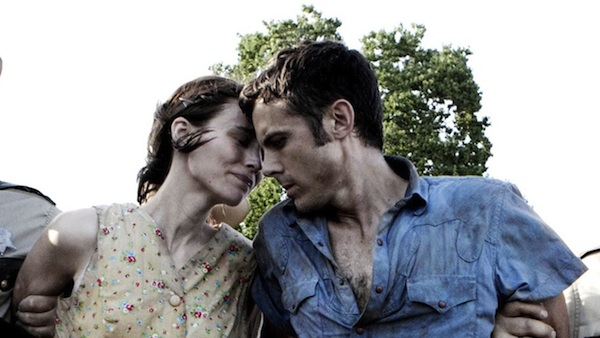Ain’t Them Bodies Saints Review
David Lowery’s Ain’t Them Bodies Saints has been compared to a Terrence Malick film for its lyrical tone, outlaw characters, persistent score, and painterly handheld cinematography. Such comparisons are understandable but a little unfair. Ain’t Them Bodies Saints is more than a mere Malick rip-off. It’s a lovely yarn about learning to let go, and while it’s arguably not as meaningful or resonant as it could be, it’s as well-acted as all hell and a signal of great things to come for its clearly talented writer-director.
The film is set in rural Texas during the 1970s, and it concerns itself primarily with two individuals—Bob Muldoon (Casey Affleck) and Ruth Guthrie (Rooney Mara). They’re lovers when we meet them, but they aren’t up to much good. Just five minutes into the film, they’re involved in a shoot out that leaves a friend dead, a cop—Ben Foster‘s Patrick Wheeler—shot, and the couple torn apart. Ruth, who’s pregnant with their child, feigns innocence (she fired the shot that wounded Wheeler), setting up a willing Bob to take the fall. He goes to prison and writes Ruth—now a single mother—nearly every day for four years. He’s coming to get them, and they’ll start over.
Bob’s quest to reclaim his family feels untenable from the start, which lends a certain air of tragedy to the film throughout. It’s not as if we necessarily want him to reunite with Ruth; if there was any doubt about them not being right for each other, we have the character of Skerritt (Keith Carradine), who’s a sort of protector of Ruth and her daughter and who threatens anyone who means them harm, intentional or otherwise. Casey Affleck plays Bob with a doe-eyed doggedness that makes him sympathetic, even a little pitiable. And Lowery adds to this dynamic by writing Ruth in a way that makes her carry guilt over Bob’s plight. (Mara, it should be noted, is excellent. In fact, this is probably her best performance to date.)
The film has a noir-like sensibility wherein it uses ominous music (the score is unique and brilliant) to unsettle its viewers without resorting to the thriller’s playbook. Its characters, too, are mysterious, and while that also leads to some frustratingly one-note “black hat” moments, it helps advance the notion that every man should dread his neighbor in this world.
It’s in terms of craft that the film is most impressive with the aforementioned score by Daniel Hart and Bradford Young’s exquisite cinematography truly making the film what it is. There’s a smallness to the story and setting that makes the film itself feel less than essential. But the grandness of Young’s images will linger with you long after the details of Bob and Ruth’s relationship have faded.
And that’s where Lowery comes in. Here’s a guy with immense talent, and leaving Ain’t Them Bodies Saints, I’m happier that he’s working in film and will have an outlet to express himself than I am with this particular effort. It’s a fine movie, but one in which the whole doesn’t add up to the sum of its parts.
















